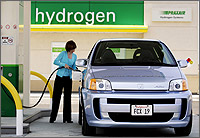The U.S. Energy Information Administration (EIA) way back on Jan. 24, 2019 released its Annual Energy Outlook 2019 with projections to 2050 (AEO2019) report.
From a related press release, the EIA announced, “The AEO2019 Reference case projects that in 2020, for the first time in almost 70 years, the United States will export more energy than it imports, and will remain a net energy exporter through 2050. U.S. energy export growth is driven largely by petroleum exports including crude oil and products, and by additional liquefied natural gas exports. These trends have become clearly established, and the Reference case shows them continuing for the next few years, and then slowing and stabilizing.”
Today’s post deals exclusively with energy consumption from within the transportation sector.
Light-duty vehicles
Domestic transportation consumes a lot of energy.
For example, according to the AEO2019 report, in 2010, light-duty vehicles consumed about 15 quadrillion British Thermal Units (Btu) of energy. In 2018, the consumption amount for the same was roughly 15.5 quadrillion Btu. That’s an approximate 500 trillion Btu increase in nine years or an average per-year increase of 55.555 trillion Btu.1
Though there was an increase had it not been for technological improvement in engine efficiency with respect to fuel economy, the energy consumption figures would no doubt have been higher. Total light-duty vehicle (LDV) vehicle miles traveled (VMT) in 2010 was somewhere in the ball park of 2.5 trillion.2 In 2018 LDV VMT was around 2.9 trillion, an increase over that span of 16 percent. This is an average year-over-year VMT growth of approximately 1.78 percent.
Meanwhile, EIA projections for LDVs after 2020 with respect to consumed energy, sees a fairly pronounced decline until year 2037, after which LDV energy consumption will again rise until year 2050.1 LDV VMT is anticipated to climb from 2.9 trillion in 2018 to 3.5 trillion miles in 2050 due to a growing population and improving economy.3
Based on current VMT trends, the expectation is that energy consumption beyond 2037 will go up. This is due in part to current standards concerning emissions of greenhouse gases (GHGs) as applied to new LDVs remaining in effect at least until year 2025*. Beyond that (presumably out to year 2050), a total absence of control measures that mandate further increases in LDV fuel efficiency is projected.4
*“‘Fuel economy will continue to improve under the Obama administration’s historic National Clean Car Program standards,’ the EPA offered. ‘The program doubles fuel economy standards by 2025 and cuts vehicle greenhouse gas emissions by half. The standards will save American families $1.7 trillion dollars [sic] in fuel costs, and by 2025 will result in an average fuel savings of more than $8,000 per vehicle. The program will also save 12 billion barrels of oil, and by 2025 will reduce oil consumption by more than 2 million barrels a day – as much as half of the oil imported from OPEC every day.’” (Source: “America’s on-the-road cars, light-duty trucks cleaner”).

Medium-/heavy-duty vehicles
Medium- and heavy-duty vehicles on the other hand according to data in the AEO report, consumed in the neighborhood of a total 6 quadrillion Btu of energy both in years 2010 and 2018.1As for medium-/heavy-duty VMT, miles driven rose from what looks to be about 350 billion in 2010 to 397 billion in 2018, a gain of around 13.43 percent or effectively a per-year average rise of 1.5 percent, pretty much mimicking the VMT trend for LDVs.2
Meanwhile, regarding projections in this category, overall VMT growth goes from 397 billion in 2018 increasing by 204 billion to 601 billion VMT in 2050, heightened activity within the economy responsible for the gain.1,3
Similar to LDVs, with present M-/H-duty truck VMT trends being what they are presently, the outlook has energy consumption for all intents and purposes remaining steady from year 2020 out to year 2037 after which until year 2050, a slight rise is expected.1 The rise in roadway travel prompts the climb in energy consumption, here again, that attributed in part to current standards of emissions of GHGs as applied in this case to new M-/H-duty trucks remaining in effect until at least year 2027.4
Aviation, light-duty commercial vehicles
As with light- and medium-/heavy-duty vehicles the patterns for aviation (A) and commercial light-duty trucks (CLDT) follow similar trajectories. Between 2010 and 2018 there is an uptick in energy usage, but unlike with CLDT, there is shown to be an ongoing increase in energy consumption between 2020 and 2050 with A1, in response to a projected rise in aviation jet fuel consumption of 35 percent from 2018 to 2050 directly tied to increased air travel activity outpacing mode fuel efficiency.4 By 2050, the revenue passenger miles for air travel is shown to be more than double that in 2010.2
Ships, buses and trains
With a noticeable dip in both marine and rail energy consumption around the period of the Great Recession, projections for the two from 2020 out, has consumption of energy holding relatively steady1 even with 11 percent and 31 percent jumps in transit bus and passenger train travel miles, respectively.3
It remains to be seen if, in next year’s report, there is no, some or at lot of change.
For the complete picture, reference the Annual Energy Outlook 2019 with projections to 2050 report from the U.S. Energy Information Administration here.
Notes
- U.S. Energy Information Administration, Annual Energy Outlook 2019 with projections to 2050, Jan. 24, 2019, p. 117
- Ibid, p. 119
- Ibid, p. 120
- Ibid, p. 118
Images: California Environmental Protection Agency Air Resources Board (2nd); Connor Harris (bottom)
Published by Alan Kandel





